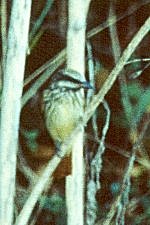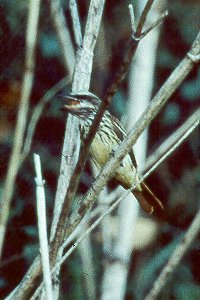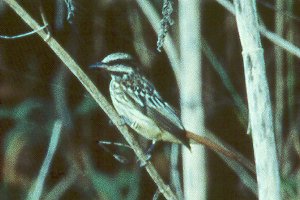
Sulphur-bellied Flycatcher (Myiodynastes luteiventris)
Owl Canyon, Bodega Bay
Sonoma County, California
Sat 09-27-1997

I shared the news with the class and decided to head straight to Bodega Bay. About five of my students followed.
We arrived about 1:30pm and the bird was still present in an isolated eucalyptus grove just north of the mouth
of Owl Canyon. Others present included Scott Terrill, Keith Hansen, Leslie & Cindy Lieurance, Hugh Cotter,
Roger Harshaw and others. Students from my class included Mark Eaton, Steve & Lillian Fuji, and Natalie White.
Later Rick Lebadore, Jennifer Matkin and others saw the bird. I spent over two hours studying the bird while numerous
observers came and went. Photos were attempted by Roger Harshaw and Scott Terrill. I understand this bird was first
found this morning by Dave MacKenzie and Dan Nelson put the word out on the Bird Box. 
The bird alternated between sitting quietly and flycatching actively. It moved from the interior of the eucalyptus to the weedy hillside and back several times. Once I heard a squeaky sound like a rubber duck from deep inside the eucalyptus when the bird was not in view. This sound was probably made by the bird. Viewing was in good light through my KOWA TSN4 and close study through a Questar made available by Roger Harshaw.
The following is based on notes taken while watching the bird:
Medium-large flycatcher, with large bill, red tail and streaked yellowish underparts.
The bill was heavy, thick, with a noticeable hook at the tip. It was dark with pale pink at the base of the lower mandible extending as a narrow pale line along the edge of the lower mandible about 2/3 of the way out.
The large head showed pale spotting on the forehead connecting to an indistinct pale supercilium that was diffused by fine dark streaking within the supercilium. A dark mask that subtended the supercilium above, extended through the dark eye and included the ear-coverts. Below the mask was a white mustache stripe that was unstreaked. Below the mustache was a black submustachial stripe that extended forward under the bill and included the chin.
The throat was white with small dark spots. Below the throat, the sides and breast were heavily streaked with dark brown becoming denser towards the malar region and connecting to the submustachial stripe. The rest of the underparts were yellow, palest on the breast and strongest on the belly and undertail coverts. The flanks were streaked more finely than the sides and breast. An apparent fine streak at the tip of the longest undertail covert proved to be a gap in the feathers, visible only in the Questar. Otherwise, the belly and undertail coverts were unstreaked.
The back was olive-brown with a greenish cast in some lights and had heavy dark brown steaks extending all the way down the back penetrating the bright rufous rump. The wings were dark. The tertials showed extensive white fringing, including the entire inner web on the innermost and getting progressively less white through the secondaries which were edged only narrowly with white. The coverts were dark with narrow white fringes on the outer webs and white tips, resulting in a complex pattern. The lesser coverts were usually concealed by dark scapular feathers, but on one occasion, they appeared to be rufous.
The bird preened occasionally and sometimes got its wings hung up in the tall weeds while foraging, allowing views of the underwings which showed yellow coverts and darker sulphur or mustard-colored axillaries.
The dark primaries extended well beyond the folded tertials. Through the Questar, I judged there to be six visible primaries, with the outer three appearing slightly dingy and the inner three appearing fresher and crisper. I tentatively concluded that the bird was undergoing primary molt.
The tail was all reddish, similar in color to the rump, except for the central two rectrices that had dark stripes extending adjacent to the shaft along the inner web. This dark stripe was broad at the base, narrowed at the tip to a point, and was fringed rufous on the inner web. The net effect was two dark lines down the top of the tail. Rectrix tips were blunt with slight wear visible on outer rectrices only (molt?).
The feet and legs appeared blackish.
Towards late afternoon, the bird frequently closed the membrane over one eye, but seemed healthy and active otherwise.
The is the third Sulphur-bellied Flycatcher I have seen in California. The first was at the Hall Ranch at Point Reyes in September 1993 and the second was a different individual at Pine Gulch Creek at Bolinas Lagoon in October 1993. There appear to be only eleven accepted records of this species in California.
DISCUSSION
 A notorious claim of Sulphur-bellied Flycatcher from Maine turned out to be the South American Variegated
Flycatcher (Empidonomus varius) after photos were examined (Abbott & Finch, American Birds 32:161-163,
1978).
A notorious claim of Sulphur-bellied Flycatcher from Maine turned out to be the South American Variegated
Flycatcher (Empidonomus varius) after photos were examined (Abbott & Finch, American Birds 32:161-163,
1978).
The Owl Canyon bird is clearly not a Variegated Flycatcher, the most obvious difference being the much larger, heavier bill of Sulphur-bellied. The closest similar species is the Middle American Streaked Flycatcher (Myiodynastes maculatus) which has a white chin, paler belly and usually yellower supercilium. Note that the claimed paler bill of Streaked Flycatcher discussed and illustrated in "A Guide to the Bird of Mexico & Northern Central America" by Howell and Webb is not a reliable distinction.
Special thanks to Leslie & Cindy Lieurance for alerting me to the bird; to Hugh Cotter for providing desperately needed note paper while the bird was in view; and especially to Roger Harshaw for generously sharing his Questar and providing the photographs.
--
Joseph Morlan
380 Talbot Avenue #206
Pacifica, CA 94044